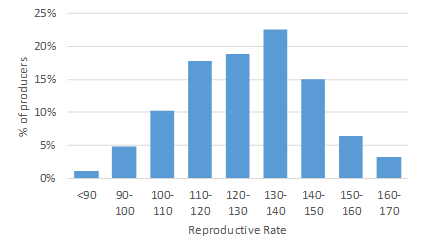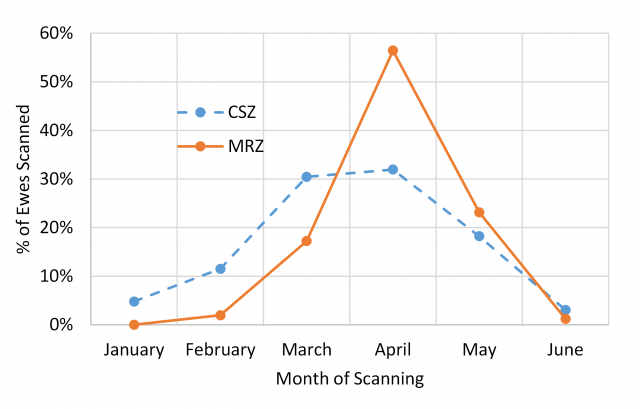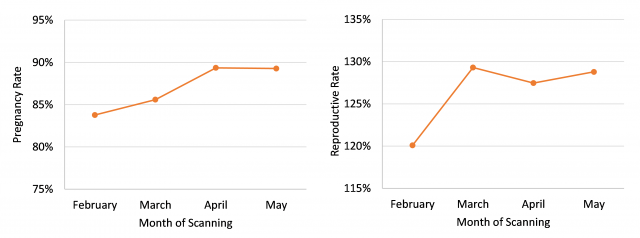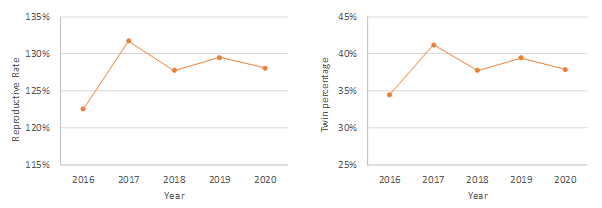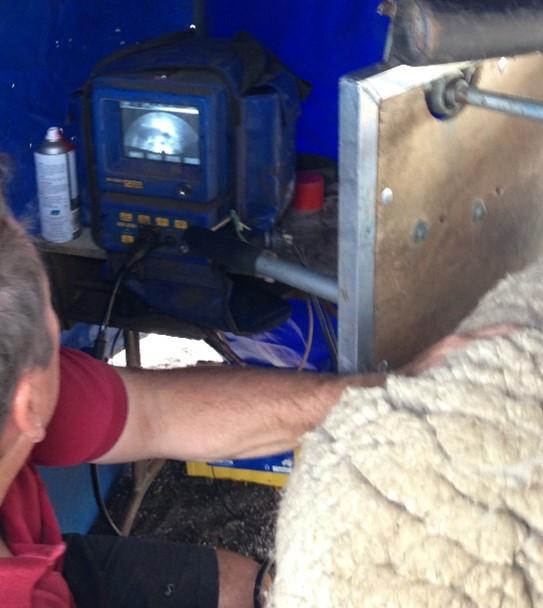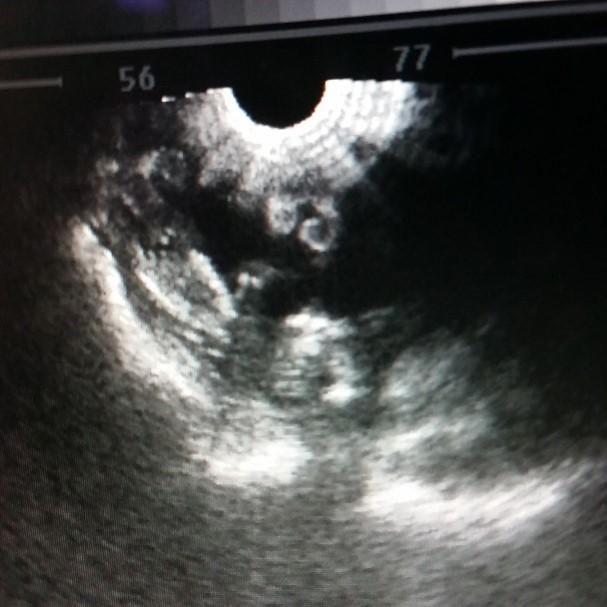Inheritance of breech strike, neck wrinkles, dags and breech cover over the lifetime of crutched Merino ewes in a Mediterranean environment
Johan Greeff DPIRD, Perth WA; Anthony Schlink (retired) and John Karlsson (retired)
Author correspondence: johan.greeff@dpird.wa.gov.au
Introduction
Breech strike continues to be a major problem for wool sheep. The main blowfly species that initiates 90% of all strikes in sheep is the Australian sheep blowfly (Lucilia cuprina), which is copper green in colour with reddish eyes.
The main methods to alleviate breech strike include mulesing lambs at an early age, ongoing crutching, and jetting sheep with an effective insecticide. However, mulesing is a sensitive issue with consumers, and continued use of chemical treatments has led to an increase in blowfly resistance to insecticides. Research in hogget sheep has shown that there are large differences between sire progeny groups in susceptibility to breech strike. Breech strike resistance is a heritable trait and makes breeding for resistance to breech strike the best long-term, permanent solution. As breech strike is also a repeatable trait, any sheep that were struck at a young age, are more likely to get struck as older sheep.
Aims
This study was undertaken to estimate the genetic parameters of breech strike and its indicator traits over the lifetime of crutched Merino ewes in a Mediterranean environment.
Methods
Breech strike records were collected on 3993 ewes over their lifetime where they were annually crutched. The ewes were scored at different times of the year for neck wrinkle, dag score and breech cover over their lifetime. A total of 13,577 breech strike records from birth up to five years of age were generated between 2006 and 2017. Face cover was only scored mid-year. Mixed model methodologies were used to estimate the genetic parameters of the different traits at different ages.
Results and discussion
Breech strike was heritable and repeatable on the observed scale, and as a binary trait on a logistic scale.
The incidence of breech strike for mature ewes in the Susceptible line was 8.1%, compared to 3.6% in the Rylington flock and 2.3% in the Resistant line (P>0.001). Breech strike was generically positively correlated across ages. The incidence of breech strike in 2-year-old ewes (9.2%) was approximately double compared to older ewes (4.8-7.7%). This study also showed that mulesing is a very effective management tool to prevent breech strike, with only 1.86% of the mulesed ewes being struck compared to 8.33% of the unmulesed ewes under the same management.
Positive genetic correlations were found between breech strike and the indicator traits of neck wrinkle, face cover, breech cover and dags.
Neck wrinkle and face cover, as well as breech cover and dag scored at different times of the year, were heritable and repeatable. Previous studies completed showed that neck wrinkle is a better predictor of breech strike compared to breech wrinkle, although high genetic correlations were found between different ages for neck wrinkle and post-shearing breech cover, these traits are not genetically the same traits at different ages. The ewes in this study were reasonably plain with a neck wrinkle score below two, only the weight of the lamb weaned had a significant phenotypic effect on neck wrinkle. Therefore, it was concluded that culling ewes on neck wrinkle score will result in a decrease in neck wrinkle, and according to Scholtz et al. (2010), it is genetically strongly correlated with breech wrinkles, which implies that breech wrinkles would also be reduced by selecting for a decrease in neck wrinkles.
The average breech cover score of the ewes in this study was approximately 2.5. Breech cover scored mid-year, before shearing and after shearing were genetically the same trait.
The genetic relationship between dag at different ages is unclear as a moderate positive genetic correlation (rg = 0.25 ± 0.12) was found between hoggets and 2-year-old ewes, whereas a moderate negative correlation (rg = –0.30 ± 0.14) was found between 3- and 4-year-old ewes. The genetic correlations amongst the dag traits in older age groups were not significantly different from zero. The average amount of dags in each age group was relatively low due to the ewes being crutched before the start of the winter rainfall. Mid-year dags were genetically strongly correlated with breech strike, whereas dag pre-shearing was not significantly different from zero, so mid-year dag qualifies as an indicator trait for breech strike.
Conclusions
Breech strike and its indicator traits; neck wrinkle, breech cover, face cover and dags, were all heritable. Breech strike appears to be genetically strongly correlated across ages, however, the correlations had large standard errors. It was positively correlated with the indicator traits. Moderate to strong genetic correlations were found between ages for neck wrinkle and for breech cover. Dags, however, were poorly correlated across ages, indicating that dags are not genetically the same trait in mature ewes at different ages.
Implications
This study showed that breech strike, neck wrinkle, dags and the wool cover traits are heritable at different ages and are low to moderately repeatable over a ewe’s lifetime. The results confirm that breech strike is genetically positively correlated with neck wrinkle, breech cover, face cover and dags. Therefore, breeding plainer sheep with less wool cover and less dags will reduce breech strike. However, although breech strike appears to be genetically the same trait at different ages, neck wrinkle, dags and breech cover did not always seem to be the same trait. Due to the low genetic correlation among dags across ages, breeding for low dags in hoggets will not result in a lowering of dags in adult ewes but as it is moderately repeatable, culling on dags will reduce dags in the current generation. As dags are the most important predisposing factor for breech strike in hogget sheep in a low wrinkle flock in the southern Mediterranean regions of Australia, the underlying causes of winter scours needs further research to determine why it is genetically a different trait in ewes of different ages. Ram breeders in the different environmental regions of Australia should therefore continue to score their adult sheep for dags at different times of the year to investigate whether selection for low dags, using hogget data, will carry over to older age groups.
Genetics is a powerful tool as any genetic gain is permanent and accumulates over time. These results imply that wool producers should not purchase or use wrinkly rams, or rams that are prone to develop diarrhoea. Ram buyers should visit the MerinoSelect website (sheepgenetics.org.au) which provides very useful breeding information on wrinkles, dags and production for a large number of potential rams. Breeders should use this information to breed more flystrike resistant sheep.
Key messages
- Breech strike, neck wrinkles, dags and the wool cover traits are heritable at different ages. Breech strike is positively correlated with neck wrinkle, breech cover, face cover and dags.
- Neck wrinkle, dags and breech cover did not always seem to be the same trait, even though breech strike appears to be genetically the same trait at different ages.
- Breeding plainer sheep with less wool cover and less dags will reduce breech strike.
- Breeders should continue to score their adult sheep for dags at various times of the year to investigate whether selecting for low dags using hogget data will carry over to older age groups.
Full paper available here: publish.csiro.au/AN/AN20415
Tools to reduce the risk of flystrike in sheep on your farm
Danny Roberts DPIRD, Albany WA and Johan Greeff DPIRD Perth, WA
Author correspondence: danny.roberts@dpird.wa.gov.au
September is normally the time when blowflies start to become a serious problem especially in long wool and uncrutched sheep.
Therefore, wool growers should monitor their flock closely and treat struck sheep immediately, by shearing the area around the strike site and treating it with an effective treatment.
Adult sheep blowflies do not travel very far from where they hatch and the risk of flystrike depends on the prevailing environmental conditions. Wet sheep and daytime temperatures higher than 15 degrees can result in both body and breech strike.
The most susceptible sheep are wrinkled and/or with dags. As dags are usually caused by worms, an effective worm management program is critically important during these times.
Sheep should be crutched to reduce the risk of flystrike in the coming months. A pre-shearing crutch can give up to six weeks protection from breech strike but is reduced to three weeks if your sheep are scouring.
Jetting and spray-on chemicals can be used as a preventative treatment to reduce the risk of flystrike but the decision needs to consider the increased risk of flystrike during this time of the year, how long before the sheep will be shorn and which chemical should be used. Rotate using different chemical groups to prevent flies becoming resistant.
Delays in shearing during spring often occur after prolonged wet weather. The risk of flystrike may be further complicated by any delays to shearing during spring. Consequently, knowing the wool withholding period (time between application of the chemical and when wool is harvested) is important consideration when choosing a chemical. Similarly, the export slaughter interval is of concern in treated sheep being sold.
Wool producers should visit DPIRD website (agric.wa.gov.au/livestock-parasites/flystrike-management-tools) to get important information on how to choose a suitable chemical to apply, access all the withholding requirements details, protection period for the different chemicals, and how to prepare a flock treatment timeline.
FlyBoss (flyboss.com.au/sheep-goats/treatment.php) also has several tools available to assist wool producers assess the risk of flies. The tools take into consideration whether sheep have been jetted, crutched, mulesed and how daggy and wrinkled the sheep are. The program will predict the risk of flystrike using real weather prediction data within 5kms of their chosen location.
Breeding for breech strike resistance offers the best long-term permanent solution. Struck sheep should be culled as breech strike is quite a repeatable trait. Sheep struck at a young age are most likely to get struck as older sheep.
To reduce a flock’s susceptibility to flystrike, wool producers need to breed more flystrike resistant sheep. Visit the Merinoselect website (sheepgenetics.org.au) to learn how to use Australian Sheep Breeding Values (ASBVs) to determine which ram is right for your flock.
Southern WA sheep reproductive rates based on pregnancy scanning
Rebecca Butcher DPIRD Moora, WA; Andrew van Burgel DPIRD Albany, WA
Author correspondence: rebecca.butcher@dpird.wa.gov.au
Introduction
Pregnancy scanning is a useful tool available to sheep producers to improve productivity and profitability. Knowing whether ewes carry singles or multiples helps with strategic paddock and supplementary feed allocation and allows appropriate feeding to increase lamb survival rates, particularly for multiples. Scanning also allows for early management decisions of dry ewes, culling in years where feed availability is low or retaining to run as whether for shearing in years when feed availability is high.
Pregnancy rate is calculated as the number of ewes scanned as pregnant per 100 ewes joined. Reproductive rate in ewes is calculated as number of scanned foetuses per 100 ewes joined. Reproductive rate is an expression of the potential lambing rate and is used to determine supplementary feeding and stocking rates for lambing, determining lamb survival rate and mapping the progress of genetic selection for reproduction traits.
Pregnancy scanning data for Merino and meat breed sheep is collected on a yearly basis from scanning consultants across southern Western Australia. DPIRD has records from 2015 to the current season with approximately 100,000 records in each year. The data is geographically distributed across two zones: the cereal sheep zone (CSZ) and the medium rainfall zone (MRZ). The CSZ extends from the Geraldton area in the north west to the Esperance region in the south east and is often known as the wheatbelt. The MRZ includes the whole south west, from the Perth area in the north, to Albany in the south and is often known as the wool belt (Figure 1). Pregnancy scanning data included across these two zones stretches from the West Midlands to south of Perth, as far west as Darkan, south to Mt Barker and east to Jerramungup and Ravensthorpe, including an area surrounding Moora including Dandaragan, Wongan Hills, Victoria Plains and Gingin Shires.
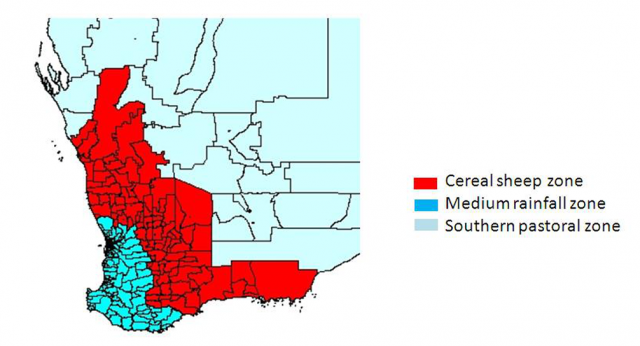
In 2020 data was collected from a total of 431,129 scanned ewes. Artificially inseminated (AI) and maiden ewe results were removed, as were non-Merino ewes. This left a total of 382,198 ewes across 236 producers, with the CSZ having 54% of producers and 46% of ewes. Results from non-Merino ewes were considerably more variable with reproductive rates averaging 0.90 and 1.40 for flocks with <500 and >500 sheep respectively.
Pregnancy and reproductive rates in 2020
The average pregnancy rate for Merino flocks was 88% (12% dries; n = 236 producers).
The average reproductive rate for Merino flocks was 128% (n = 93 producers), with most producers between 130-140%. Excluding one low outlier, the range of reproductive rates was from 97% to 166% (Figure 2).
The reproductive rates were not significantly different between the CSZ (130%) and MRZ (127%). The CSZ had significantly more twins (40 vs 36%) which was offset by a 2% lower pregnancy rate.
In a similar way, pregnancy rates were significantly higher for producers with larger flocks (>1000 ewes) at 89% compared to 85% for smaller flocks (<1000 ewes), however the larger flocks had less twins (37% vs 42%) so that the reproductive rates were not significantly different between groups.
Pregnancy rates were also significantly higher for producers that scanned for twins (90%) compared to producers that only scanned for pregnancy (87%).
Month of scanning
The time of scanning was earlier for the CSZ with nearly half (47%) of ewes scanned by March, while only 19% of ewes in the MRZ were scanned by March (Figure 3).
The pregnancy rate for scanning in February (84%) and March (86%) were significantly lower than the pregnancy rate for April (89%) (Figure 4). The reproductive rate was also lower for scanning in February, but not for March. The reproductive rate dataset is smaller and the differences in reproductive rate between months is not statistically significant.
Reproductive rate trends over time
Reproductive rates were calculated from 2016 to 2020 (Figure 5). There was a significant increase from 2016 (123%) to 2017 (132%), followed by a significant decrease in 2018 (128%). The pattern in reproductive rate followed the pattern in percentage of twins.
Sheep pregnancy scanning benchmark tool
This tool is a simple calculator for sheep producers that allows them to benchmark sheep pregnancy (reproductive) scanning rates against flocks with similar genotypes and time of lambing in the region. It provides producers with an idea of their potential lambing, the region’s best practice and where their flock’s performance sits in relation to other flocks.
This tool is available on the DPIRD website agric.wa.gov.au/sheep/pregnancy-scanning-benchmarks.
Importance of scanning
Knowing pregnancy status and number of lambs conceived is important for allocating adequate feed and paddocks, especially to twin bearing ewes. Scanning can assist with management decisions such as whether or not to cull dry ewes or keep to run as wethers for wool production. The value of pregnancy scanning increases during poor seasons or times of likely feed shortage affecting pregnancy.
Seasonal conditions impact on joining and subsequent scanning data. Having ewe condition score at joining and/or scanning would add value to the pregnancy scanning dataset.
References
Brien, Forbes. 2020. Why scanning makes sense. mla.com.au/news-and-events/industry-news/why-scanning-makes-sense/
Are you interested in the biosecurity of Western Australia’s agricultural industries?
Rebecca Heath DPIRD, Northam WA
Author correspondence: rebecca.heath@dpird.wa.gov.au
Western Australian producers and other stakeholders in the dairy, beef, grain/seed, hay, sheep and/or goat industries and respective supply chains are invited to apply for positions on Industry Funding Scheme Management Committees.
Industry Funding Schemes enable agricultural industries to raise funds to address priority pests and diseases at a whole-of-industry level.
The schemes are industry-driven and overseen by a Management Committee made up of producers and others with appropriate industry knowledge and expertise.
The Minister for Agriculture and Food will appoint members for a period of up to three years commencing 1 July 2022. The Department of Primary Industries and Regional Development provides support to the schemes and committees.
From 1 July 2022, there will be vacancies on the following Management Committees:
- Cattle Industry Funding Scheme (4 vacancies)
- Grains, Seeds and Hay Industry Funding Scheme (3 vacancies)
- Sheep and Goat Industry Funding Scheme (3 vacancies)
The Management Committees meet quarterly on dates agreed by members, and members are remunerated, including sitting fees and travel expenses.
Expressions of interest can be made online at agric.smartygrants.com.au/IFSEOI. Alternatively, you can submit your expression of interest by email. This should include a three-page letter addressing the selection criteria and a current resume of a maximum of two pages.
Online applications are the preferred method for submitting an expression of interest. Emailed applications can be sent to Rebecca Heath.
Expressions of interest close on 31 October 2021.
More information, including the terms of reference and selection criteria, is available on the Department of Primary Industries and Regional Development website at agric.wa.gov.au. Search for ‘Committee membership EOIs’.
The Western Australian Government is committed to ensuring diversity on government boards and committees.

